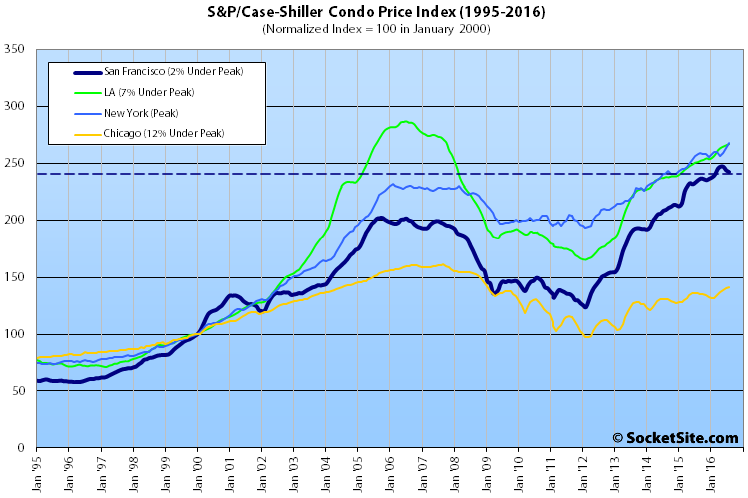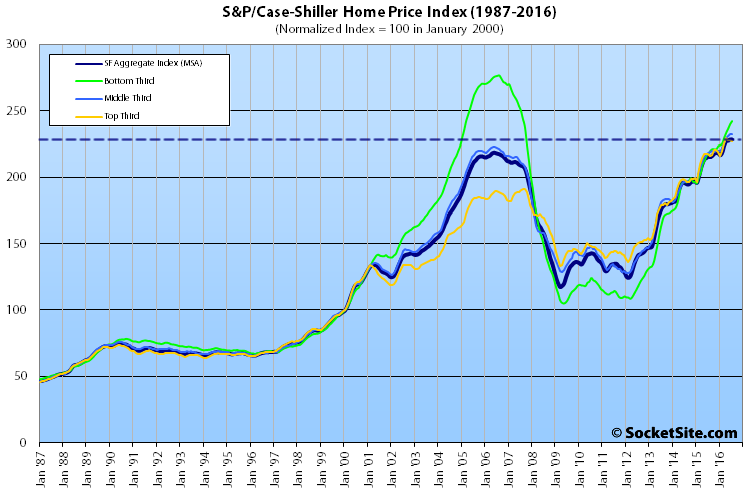Having ticked up 0.4 percent to a record high in June, the Case-Shiller Index for single-family home values within the San Francisco Metropolitan Area stalled in July and the index for Bay Area condo values slipped for the second month in a row.
In addition, the year-over-year gain for the main index, the pace of which has been on the decline since the third quarter of 2015, measured 6.0 percent in July, the lowest year-over-year gain since the third quarter of 2012.
That being said, the index for the bottom third of the Bay Area single-family home market, which has more than doubled since bottoming in 2009, gained another 0.9 percent in July and is running 10.9 percent higher versus the same time last year but still remains 12.0 percent below its 2006 peak.
The index for the middle third of the market, which has gained 82 percent since 2009, was unchanged in July and is currently running 6.4 percent higher versus the same time last year and 4.4 percent above its 2006-era peak.
And while the index for the top-third of the Bay Area market remains 18.9 percent above its previous cycle peak recorded in August 2007, it slipped 0.3 percent in July and its year-over-year gain of 4.8 percent is the lowest on record since the third quarter of 2012.
Having dropped 1.3 percent in June, which was the first month-over-month drop of over a percent since the first quarter of 2012, the index for San Francisco area condo values slipped another 0.6 percent in July and the year-over-year gain slipped to 4.0 percent, the smallest year-over-year gain since the second quarter of 2012. But the index remains 20.0 percent higher than its previous cycle peak in October 2005.
The index for home prices across the nation ticked up 0.7 percent from June to July and is now within one percent of its July 2006 peak while the year-over-year gain ticked up to 5.1 percent.
And for the fifth month in a row, Portland, Seattle and Denver reported the highest year-over-year gains, up 12.4 percent, 11.2 percent and 9.4 percent respectively.
Our standard SocketSite S&P/Case-Shiller footnote: The S&P/Case-Shiller home price indices include San Francisco, San Mateo, Marin, Contra Costa and Alameda in the “San Francisco” index (i.e., greater MSA) and are imperfect in factoring out changes in property values due to improvements versus appreciation (although they try their best).


Its beginning to look like a long overdue and healthy rebalancing of SF prices is occurring. Rebalancing in the sense other vibrant markets such as Seattle, Denver and Portland will outgain the Bay Area in appreciation perhaps for an extended number of years to come.
I’m not saying these other markets will surpass the Bay Area in prices – just to be clear on that. Only that the disparity will shrink to a more normal historic level.
Supply is growing, so prices are starting to stagnate. Are you watching, NIMBYs?
You mean you don’t know the term for when pricing exceeds buyers ability?
You mean you don’t know how to interpret an index of average prices? There are plenty of able buyers at all levels – sales volume is up, but inventory is up even more. This is supply-driven, not demand-driven.
While Seattle is far outpacing San Francisco on a per capita basis in terms of housing production, the overwhelming portion of Seattle’s new construction supply has been in rental units. Very very little of the new production has been condos (and almost nothing in terms in SFR production within the city limits). So its not surprising that prices there continue to rise – job growth continues in Seattle (primarily driven by Amazon) but there’s no new product for anyone to buy, only rent.
The high paid folks relocating to Seattle and Portland are/will drive demand for SFRs. Especially as they have families. This is why SFH rental property is a potentially good medium in these markets.
As appreciation slows here relative to some other markets I think there will be a shift to an extent of some investment RE money out of the Bay Area. Further relieving the upward pressure on prices here and as such benefitting potential first time home buyers here.
Where exactly would standard single family home subdivisions be developed in Seattle? There is not exactly a lot of vacant land. Or are you talking about the metropolitan area in general?
Up 6.0% YOY, triple the inflation rate (4.0% for condos, double inflation). And still faster price increases in SF than 12 of 20 metro areas despite the huge increases in recent years here. Month-to-month changes are just noise. A year ago, I predicted flat to slightly down prices. But the crazy high prices continue, getting still crazier. I really don’t see any compelling evidence that things are going to change radically (barring a Trump surprise victory), but I’d like to see things flatten out. That would be healthier for everyone but recent, over-stretched buyers. Wish list for a year from now – 3% inflation and flat SF housing prices.
agreed
Keep an eye on the relative performance and divergence of the tiers. Over the past quarter, not simply a month, the index for the top third of the Bay Area market, which skews toward San Francisco proper, has actually slipped about a percent while the bottom third of the market, which is driven by the lower-cost East Bay market, has gained closer to four percent and propped the overall index up.
Condos will continue flat to down with current inventory, plus some owner at the Millennium will HAVE to sell in the next 12 months, and that will re-mark all of those homes down substantially, which will affect mix/pricing.
Condo inventory 2 years out is much more limited, so waiting to buy will involve some game theory – when to jump in.
If you’re renting, you’re short real estate. Is SF the right place to be short real estate?
SFR over $1M have slipped too, the main thing propping up the SFR market at this point is that rents remain crazy high. Mom and pop landlords (citizenship may vary) are buying sub $1M homes in D2, 3, and 10 because they are cash flow positive. Especially after adding the illegal inlaw unit.
Interesting that the last time prices peaked/flattened before turning SF lead the way ahead of NY/LA. Likewise so did the top tier lead the middle (barely) and lower tiers. It certainly looks like that’s playing out again. That said the real question is: will the market turn downwards as sharply again after that? Will it recover as quickly if it does? For me the biggest question is how sustainable these prices are over the longer term. JR, more interesting than where does this index fall in 1 year is where does it fall in 10? 20? 30?